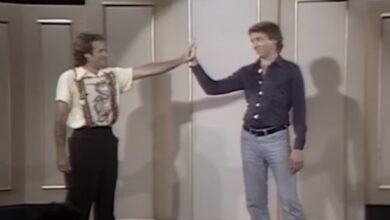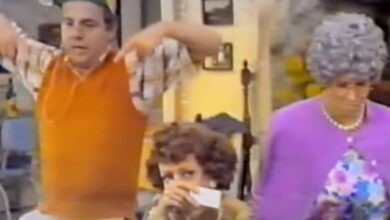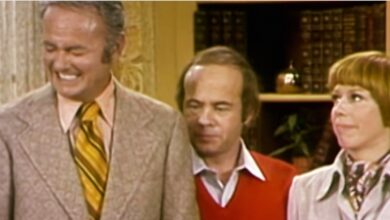Mary Hopkin’s “Those Were the Days” – A Bittersweet Time Capsule That Captured a Generation
When “Those Were the Days” hit the airwaves in 1968, it wasn’t just a song—it was a phenomenon. It launched Mary Hopkin, a young Welsh singer, into worldwide fame and became an anthem of reflection for a generation. With its Eastern European folk-inspired melody, sweeping orchestration, and poetic lyrics, it stood out dramatically from the dominant psychedelic rock of the time. Topping the UK charts and reaching No. 2 in the U.S., it quickly became one of the most iconic tracks of the decade.
Hopkin’s rise to international stardom came through a unique chain of events. Growing up in Pontardawe, Wales, she had a deep appreciation for folk traditions and developed a distinctive voice that was gentle yet emotionally resonant. Her victory on the TV talent show “Opportunity Knocks” caught the eye of Twiggy, who recommended her to Paul McCartney. At the time, The Beatles had just launched Apple Records, and McCartney, always keen to support emerging talent, decided to sign Hopkin as one of the label’s first artists.
The roots of “Those Were the Days” go much further back than the 1960s. The melody came from a Russian romance song titled “Dorogoi dlinnoyu,” written by Boris Fomin and lyricist Konstantin Podrevsky. The music’s haunting quality carried deep emotional undertones. American musician Gene Raskin later penned English lyrics, turning it into a story of youthful dreams, time lost, and a longing for what once was. The timeless emotions captured in the lyrics gave the song universal appeal.
Paul McCartney played a crucial role in bringing the song to life in the studio. As the producer, he shaped the recording with a distinctive sonic palette that included a dramatic harpsichord introduction and a blend of classical and folk instrumentation. His attention to detail created an atmosphere that was both theatrical and intimate. Hopkin’s innocent yet rich voice delivered the lyrics with sincerity and depth, allowing the emotional narrative to unfold naturally.
Upon its release, “Those Were the Days” quickly captivated listeners across the globe. It climbed to the top of the UK charts, even surpassing The Beatles’ “Hey Jude,” and sold millions of copies. The track’s success transcended musical tastes, earning fans from the pop, folk, and traditional music communities alike. The song’s sentiment struck a chord with listeners from various backgrounds, all of whom saw pieces of their own stories in its bittersweet message.
More than just a chart-topper, the song held a mirror to the cultural climate of its time. Amidst the chaos of protests, war, and social transformation, “Those Were the Days” offered a comforting look back at simpler moments. Its melancholic tone and reflective lyrics made it a perfect backdrop for a generation grappling with rapid change. In a world spinning forward, the song stood as a gentle reminder of the dreams and innocence left behind.
While the song brought Hopkin international recognition and follow-up singles like “Goodbye,” it also became a double-edged sword. “Those Were the Days” set such a high standard that every subsequent release was inevitably compared to it. Though she continued to release music and build a loyal following, Hopkin increasingly preferred to step back from the spotlight and return to the folk roots she loved most deeply.
The influence of the song went far beyond Hopkin’s own career. It demonstrated that folk-inspired music still had a strong place in the evolving world of pop. The arrangement, combining lush orchestration with folk storytelling, set a precedent for many future artists. Musicians like Simon & Garfunkel and even early Elton John incorporated similar elements into their work, reflecting the stylistic doors this track had helped open.
The song’s appeal led to a wide variety of cover versions across the globe. From Dalida’s emotional French take “Le temps des fleurs” to interpretations by Dolly Parton, Engelbert Humperdinck, and Sandie Shaw, artists from many genres paid tribute to its message. Each brought their own voice to the tune, but none could fully replicate the distinct emotional weight of Hopkin’s original recording, which remains the definitive version for many listeners.
As Hopkin’s fame skyrocketed, she became closely associated with The Beatles’ inner circle. She performed on numerous high-profile television programs and appeared on “The Ed Sullivan Show,” all while navigating the pressures of sudden celebrity. Over time, the demands of fame began to wear on her, and she gradually shifted her focus away from the pop spotlight and toward more personal and folk-centered musical projects.
Decades after its release, “Those Were the Days” continues to resonate. It has been featured in film soundtracks, nostalgic collections, and playlists celebrating timeless classics. Its ability to stir deep emotions in listeners of all ages speaks to its enduring quality. The song doesn’t just reflect on the past—it captures the essence of remembering and feeling, giving every listener a chance to relive their own golden days.
In the broader context of music history, the song played a significant role in legitimizing Apple Records as a major label. It proved that the label could deliver hits beyond The Beatles’ discography and highlighted Paul McCartney’s skill as a producer. His artistic touch in shaping Hopkin’s debut set the stage for a lasting impact on the music industry beyond his own performance career.
Even though she moved away from mainstream success, Mary Hopkin never entirely disappeared from the music world. She remained creatively active, producing music independently and staying connected to her audience in her own quiet way. “Those Were the Days” remains her most iconic song, but it also marked a pivotal chapter in the evolution of folk-pop—a moment where simplicity, emotion, and melody came together to create something truly unforgettable.
Today, the song stands as a universal reminder of the passage of time and the memories we all hold dear. It transcends generations and genres, speaking to anyone who has ever looked back on their youth with both joy and longing. “Those Were the Days” is more than just a hit—it’s a cultural artifact, a reflection of human experience, and a melody that lingers long after it ends.





